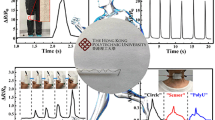Abstract
Flexible and multifunctional textile-based electronics have been promising for wearable devices. However, integrating excellent conductivity into textiles without sacrificing their fundamental flexibility and breathability remains challenging. In this work, the interconnected conductive networks are created with a knitted polyester fabric. The knitted fabric is spray coated with one-dimensional carbon nanotubes and two-dimensional graphene nanosheets to integrate unique metallic conductivity. The change in resistance of interconnected loops during stretching, their behavior, and electrical properties were analyzed. The resultant electrically conductive CNTs/GNs-knitted fabric offers an outstanding electrical conductivity of 36.5 S m−1 with superior Joule heating performance up to 282 °C at a supply voltage of 10 V. Moreover, the stitch structure of the fabric was simulated as a circuit model consisting of the course and wale yarn and their contact resistance. The simulated results agreed with the experimental data, and the significant trends of both results were consistent. The multifunctional, electrically conductive, and thermally stable CNTs/GNs-knitted fabric presented in this work is promising for potential applications in textile-based wearable devices.









Similar content being viewed by others
Data availability
The data that support the findings of the study are available from the corresponding author upon reasonable request.
References
W. Zeng, L. Shu, Q. Li, S. Chen, F. Wang, X.M. Tao, Adv. Mater. 26, 5310 (2014)
G. Chen, Y. Li, M. Bick, J. Chen, Chem. Rev. 120, 3668 (2020)
W. Weng, P. Chen, S. He, X. Sun, H. Peng, Angew. Chem. Int. Ed. Engl. 55, 6140 (2016)
Z. Yang, H. Sun, T. Chen, L. Qiu, Y. Luo, H. Peng, Angew. Chem. Int. Ed. Engl. 125, 7693 (2013)
Z. Zhang, X. Li, G. Guan, S. Pan, Z. Zhu, D. Ren, H. Peng, Angew. Chem. Int. Ed. Engl. 53, 11571 (2014)
C. Zhao, K. Shu, C. Wang, S. Gambhir, G.G. Wallace, Electrochim Acta. 172, 19 (2015)
H. Lee, M.J. Glasper, X. Li, J.A. Nychka, J. Batcheller, H.J. Chung, Y. Chen, J. Mater. Sci. 53, 9026 (2018)
H. Kim, S. Lee, H. Kim, Sci. Rep. 9, 1 (2019)
K.R. Reddy, S. Gandla, D. Gupta, Adv. Mater. Int. 6, 1900409 (2019)
L. Sun, F. Wang, J. Jiang, H. Liu, B. Du, M. Li, Y. Liu, M. Li, Cellulose 27, 8923 (2020)
X. Hong, W. Zhao, R. Yu, Q. Wang, F. Zeng, Y. Tao, Z. **, C. Zhu, J. Ind. Text. 15280837221076029 (2022).
M. Zahid, E.L. Papadopoulou, A. Athanassiou, I.S. Bayer, Mater. Des. 135, 213 (2017)
S. Afroj, N. Karim, Z. Wang, S. Tan, P. He, M. Holwill, S. Ghazaryan, A. Fernando, K.S. Noboselov, ACS Nano 13, 3847 (2019)
X. Zhang, X. Wang, Z. Lei, L. Wang, M. Tian, S. Zhu, H. **ao, X. Tang, L. Qu, A.C.S. Appl, Mater. Int. 12, 14459 (2020)
S. Iijima, Nature 354, 56 (1991)
M.F.L. De Volder, S.H. Tawfick, R.H. Baughman, A.J. Hart, Science 339, 535 (2013)
Y. Jun, T. Kim, C.R. Park, Carbon 88, 60 (2015)
K. Parikh, K. Cattanach, R. Rao, D.S. Suh, A. Wu, S.K. Manohar, Sens. Actuators B Chem. 113, 55 (2006)
Y. Wang, Z. Yang, Z. Hou, D. Xu, L. Wei, E.S. Kong, Y. Zhang, Sens. Actuators B Chem. 150, 708 (2010)
Z. Li, P. Dharap, S. Nagarajaiah, E.V. Barrera, J.D. Kim, Adv. Mater. 16, 640 (2004)
L. Xu, Z. Liu, H. Zhai, X. Chen, R. Sun, S. Lyu, Y. Fan, Y. Yi, Z. Chen, L. **, J. Zhang, Y. Li, T.T. Ye, A.C.S. Appl, Mater. Int. 12, 13265 (2020)
Y. Lu, M. Tian, X. Sun, N. Pan, F. Chen, S. Zhu, X. Zhang, S. Chen, Compos. Part A Appl. Sci. 117, 202 (2019)
H. Ma, W. Wu, J. Cao, B. Yue, H. Zhang, Carbon 114, 731 (2017)
Acknowledgements
This research was supported by Zhejiang Provincial Natural Science Foundation of China (Grant no. LZJWY22B070003); Science Foundation of Zhejiang Sci-Tech University (Grant nos. 2020YBZX10 and 20202094-Y)
Author information
Authors and Affiliations
Corresponding author
Ethics declarations
Conflict of interest
The authors declare that they have no conflict of interest.
Rights and permissions
Springer Nature or its licensor (e.g. a society or other partner) holds exclusive rights to this article under a publishing agreement with the author(s) or other rightsholder(s); author self-archiving of the accepted manuscript version of this article is solely governed by the terms of such publishing agreement and applicable law.
About this article
Cite this article
Shao, Y., Song, Q., Chen, W. et al. Characteristics of Electrical Heating and Sensing Properties for CNTs/GNs Polyester-Knitted Fabrics Based on Network Structure. Fibers Polym 24, 1139–1148 (2023). https://doi.org/10.1007/s12221-023-00119-6
Received:
Revised:
Accepted:
Published:
Issue Date:
DOI: https://doi.org/10.1007/s12221-023-00119-6




